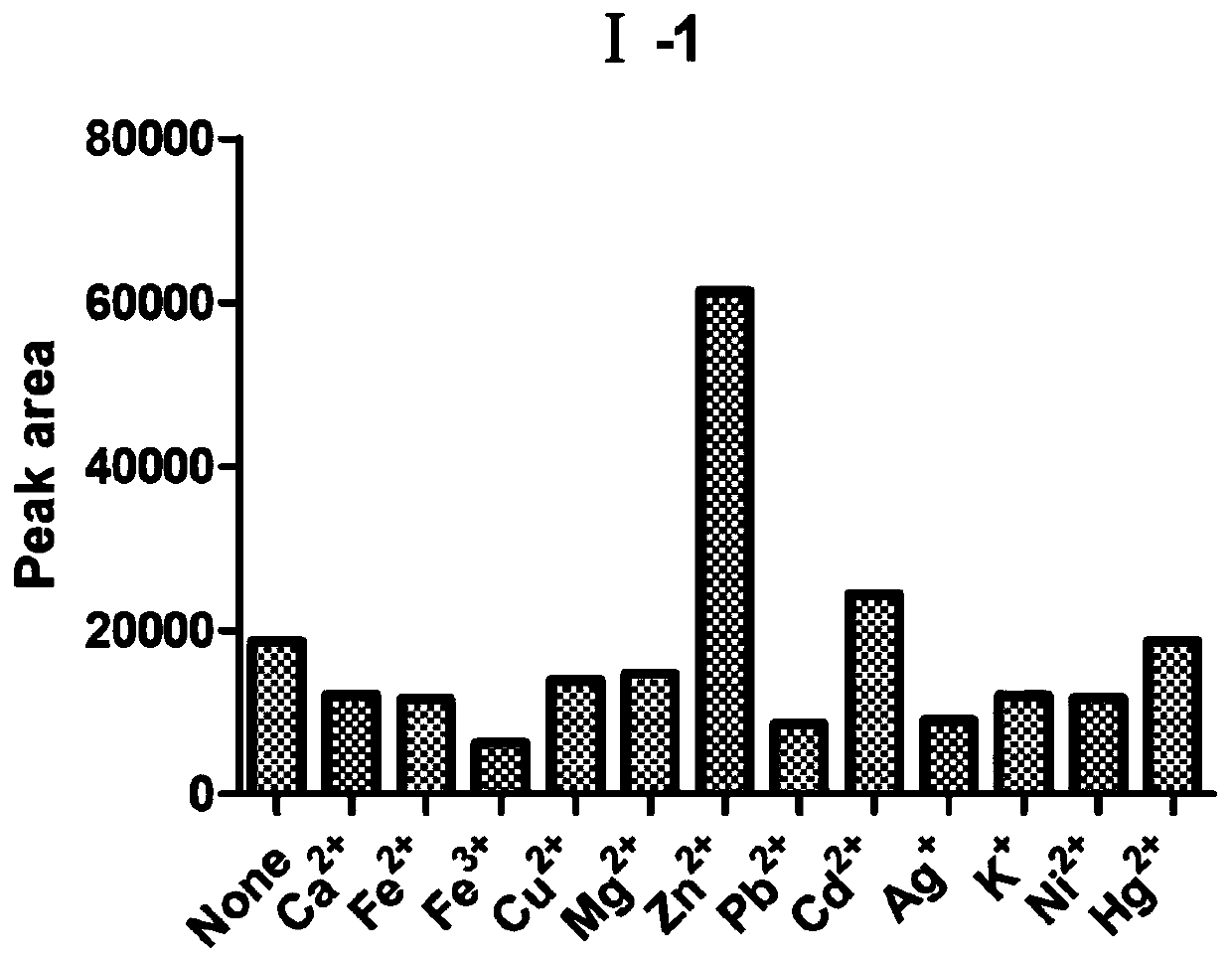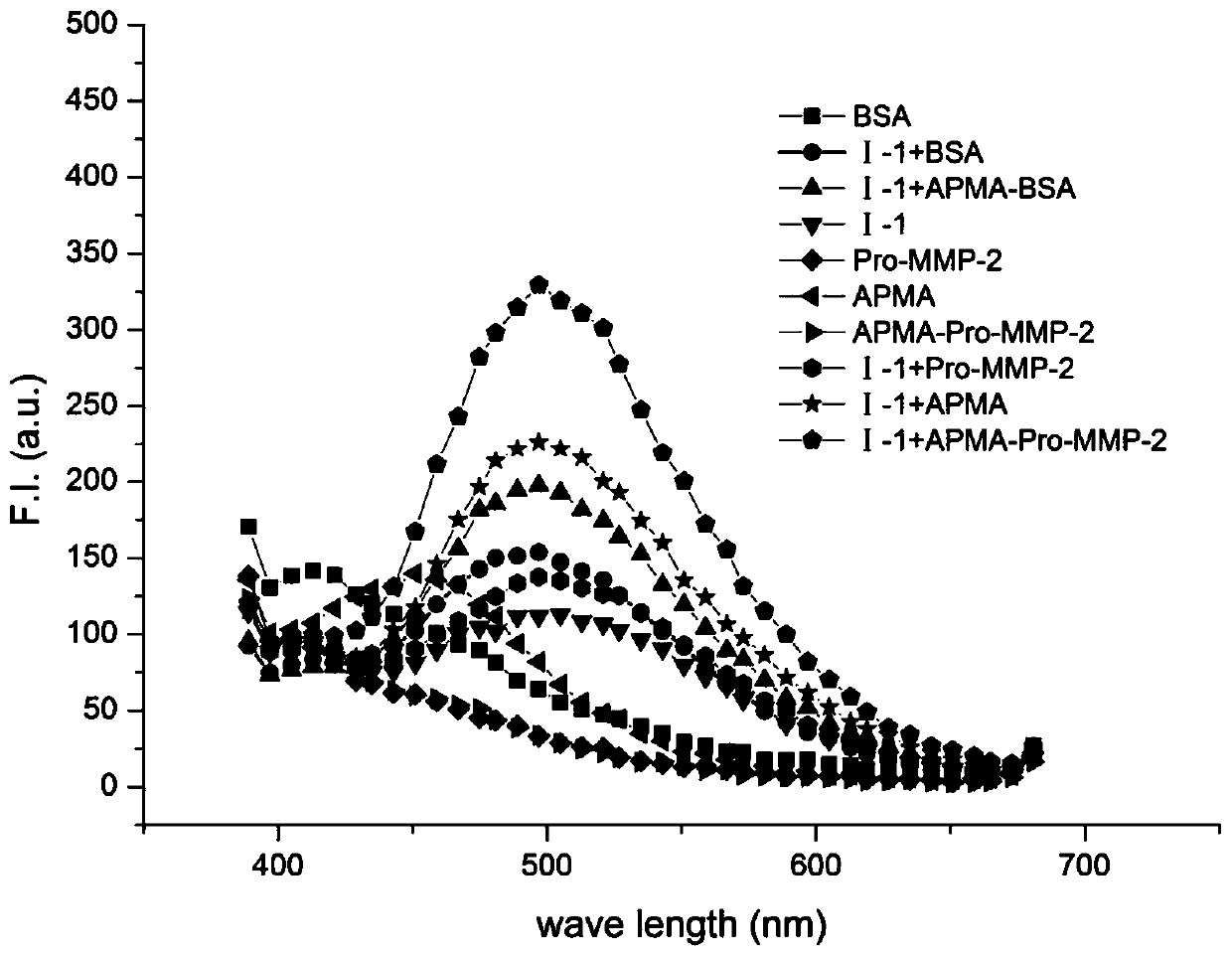Small-molecule fluorescent probe for detecting matrix metalloproteinase, and preparation method and application thereof
A technology of fluorescent probes and matrix metals, which is applied in the field of preparation of small molecule fluorescent probes, can solve the problems that matrix proteases cannot be visualized in situ, cannot detect matrix metalloproteinases, and the scope of application is not wide enough to achieve good facultative, Good compatibility and good stability
- Summary
- Abstract
- Description
- Claims
- Application Information
AI Technical Summary
Problems solved by technology
Method used
Image
Examples
Embodiment 1
[0036] Small molecule fluorescent probe molecule Ⅰ-1 (structural formula: ) preparation:
[0037]Weigh 112.61mg of 8-hydroxyquinoline-5-sulfonic acid (225.22g / mol), add 30% hydrogen peroxide, stir in ice bath for 2 hours, then stir and react at room temperature overnight, TLC thin-layer chromatographic board monitors 8-hydroxyl Quinoline-5-sulfonic acid reacted completely. Then, manganese dioxide was added in small amounts several times, stirred overnight at room temperature, filtered, and the water layer was freeze-dried at -60°C to obtain a light yellow solid product Ⅰ-1. FTMS-cESI[M-H] - : m / z 239.9969.
[0038] Fluorescence intensity changes before and after the reaction of small molecule fluorescent probe molecule Ⅰ-1 with various metal ions:
[0039] Dissolve the probe molecule Ⅰ-1 in pure water to make a 10mM mother solution, dilute it 1000 times (10μM) for use; add calcium chloride (CaCl 2 ), ferrous sulfate (FeSO 4 ), ferric chloride (FeCl 3 ), copper chloride...
Embodiment 2
[0049] Small molecule fluorescent probe molecule Ⅰ-2 (structural formula: ) preparation:
[0050] Weigh 112.61mg of 8-hydroxyquinoline-2-sulfonic acid (225.22g / mol), add 30% hydrogen peroxide, stir in ice bath for 2 hours, then stir and react at room temperature overnight, TLC thin-layer chromatographic board monitors 8-hydroxyl Quinoline-5-sulfonic acid reacted completely. Then, manganese dioxide was added in small amounts several times, stirred overnight at room temperature, filtered, and the aqueous layer was freeze-dried at -60°C to obtain a pale yellow solid product Ⅰ-2. FTMS-cESI[M-H] - : m / z 239.9968.
Embodiment 3
[0052] Small molecule fluorescent probe molecule Ⅰ-3 (structural formula: ) preparation:
[0053] Take by weighing 200mg 8-hydroxyquinoline-2-carboxylic acid (189.17g / mol), measure 10ml 30% hydrogen peroxide, stir and react at room temperature overnight, TLC thin-layer chromatographic board monitors 8-hydroxyquinoline-7-carboxylic acid Total response. Then, manganese dioxide was added in small amounts several times, stirred overnight at room temperature, filtered, and the water layer was freeze-dried at -60°C to obtain a light yellow solid product Ⅰ-3. FTMS-cESI[M-H] - : m / z 204.0299.
PUM
 Login to View More
Login to View More Abstract
Description
Claims
Application Information
 Login to View More
Login to View More - R&D
- Intellectual Property
- Life Sciences
- Materials
- Tech Scout
- Unparalleled Data Quality
- Higher Quality Content
- 60% Fewer Hallucinations
Browse by: Latest US Patents, China's latest patents, Technical Efficacy Thesaurus, Application Domain, Technology Topic, Popular Technical Reports.
© 2025 PatSnap. All rights reserved.Legal|Privacy policy|Modern Slavery Act Transparency Statement|Sitemap|About US| Contact US: help@patsnap.com



